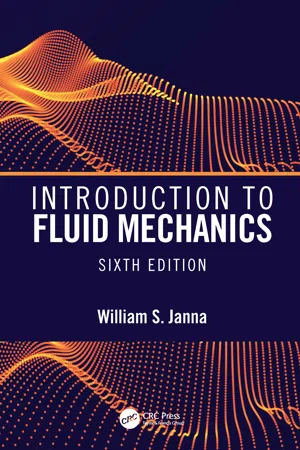Fluid Dynamics
Fluid dynamics is the study of fluids in motion, including liquids and gases. It explores how these substances behave and interact with their environment, encompassing phenomena such as turbulence, flow patterns, and pressure. This field is crucial in various engineering applications, from designing aircraft and vehicles to understanding weather patterns and ocean currents.
6 Key excerpts on "Fluid Dynamics"
- eBook - ePub
- Richard Gentle, Peter Edwards, William Bolton(Authors)
- 2001(Publication Date)
- Newnes(Publisher)
...3 Fluid mechanics Summary Fluid mechanics is the study of the behaviour of liquids and gases, and particularly the forces that they produce. Many scientific disciplines have an interest in fluid mechanics. For example, meteorologists try to predict the motion of the fluid atmosphere swirling around the planet so that they can forecast the weather. Physicists study the flow of extremely high temperature gases through magnetic fields in a search for an acceptable method of harnessing the energy of nuclear fusion reactions. Engineers are interested in fluid mechanics because of the forces that are produced by fluids and which can be used for practical purposes. Some of the well-known examples are jet propulsion, aerofoil design, wind turbines and hydraulic brakes, but there are also applications which receive less attention such as the design of mechanical heart valves. The purpose of this chapter is to teach you the fundamentals of engineering fluid mechanics in a very general manner so that you can understand the way that forces are produced and transmitted by fluids that are, first, essentially at rest and, second, in motion. This will allow you to apply the physical principles behind some of the most common applications of fluid mechanics in engineering...
- eBook - ePub
- William S. Janna(Author)
- 2020(Publication Date)
- CRC Press(Publisher)
...1 Fundamental Concepts Fluid mechanics is the branch of engineering that deals with the study of fluids—both liquids and gases. Such a study is important because of the prevalence of fluids and our dependence on them. The air we breathe, the liquids we drink, the water transported through pipes, and the blood in our veins are examples of common fluids. Further, fluids in motion are potential sources of energy that can be converted into useful work—for example, by a waterwheel or a windmill. Clearly, fluids are important, and a study of them is essential to the engineer. After completing this chapter, you should be able to: Describe commonly used unit systems; Define a fluid; Discuss common properties of fluids; Establish features that distinguish liquids from gases; and Present the concept of a continuum. 1.1 DIMENSIONS AND UNITS Before we begin the exciting study of fluid mechanics, it is prudent to discuss dimensions and units. In this text, we use two unit systems: the British gravitational system and the international system (SI). Whatever the unit system, dimensions can be considered as either fundamental or derived. In the British system, the fundamental dimensions are length, time, and force. The units for each dimension are given in the following table: British Gravitational System Dimension Abbreviation Unit Length L foot (ft) Time T second (s) Force F pound-force (lbf) Mass is a derived dimension with units of slug and defined in terms of the primary dimensions as 1 slug = 1 1 bf ⋅ s 2 ft (1.1) Converting from the unit of mass to the unit of force is readily accomplished because the slug is defined in terms of the lbf (pound-force). Example 1.1 An individual weighs 150 lbf. a. What is the person’s mass at a location where the acceleration due to gravity is 32.2 ft/s 2 ? b. On the moon, the acceleration due to gravity is one-sixth of that on earth. What is the weight of this person on the moon? Solution a...
- eBook - ePub
- B.H Brown, R.H Smallwood, D.C. Barber, P.V Lawford, D.R Hose(Authors)
- 2017(Publication Date)
- CRC Press(Publisher)
...As in structural mechanics, the aeronautical engineers have been there before us. Many of the modern computational fluid-dynamics (CFD) structures, algorithms and software were developed originally in or for the aeronautical industry. Some simplifications, such as that of inviscid flow, can lead to equations that are still worth solving for complex geometries. Special techniques have been developed, particularly for the solution of two-dimensional problems of this type. These are not discussed here because they are not particularly relevant to problems in biofluid mechanics. Turbulence is a phenomenon of primary interest to aerodynamicists, and this is reflected in the number of turbulence models that are available in commercial software and in the richness of the literature in this field. Moving boundaries (pistons and valves) are of great interest to automobile engineers in the modelling of combustion processes, and again facilities to model events featuring the motion of a boundary have existed for some time in commercial software. Of much more interest to those involved in biofluid mechanics are the problems of the interaction of soft and flexible structures with fluid flow through and around them. Historically structural and fluid-dynamic analyses have been performed by different groups of engineers and physicists, and the two communities had relatively little contact. This situation has changed dramatically in recent years. It is the authors’ belief that we stand on the verge of a revolution in our abilities to handle real problems in biofluid mechanics. 2.8.1 The differential equations For an incompressible fluid the continuity equation is ∂ u ∂ x + ∂ v ∂ y + ∂ w ∂ z = 0 where x, y and z are a set of Cartesian coordinates and u, v and w are the velocities in these three directions. The momentum equation in the x direction for a Newtonian fluid, in the absence of body forces,...
- eBook - ePub
Introduction to Engineering Mechanics
A Continuum Approach, Second Edition
- Jenn Stroud Rossmann, Clive L. Dym, Lori Bassman(Authors)
- 2015(Publication Date)
- CRC Press(Publisher)
...20 Fluid Dynamics: Applications That we have written an equation does not remove from the flow of fluids its charm or mystery or its surprise. Richard Feynman, 1964 We have found two distinct ways to apply the fundamental concepts of mass conservation and ∑ F = m a to fluids. We now want to identify some canonical problems of fluid mechanics, their historical context, and their relevance to us. Both solid and fluid mechanics are enormous fields, with many rich details; in this book, we have been necessarily brief with both of them. We encourage further study of both areas, and of the field of continuum mechanics; please consult the References listed at the end of this book. 20.1 How Do We Classify Fluid Flows? The Navier–Stokes equation contains terms corresponding to several possible forces on a fluid element. If we look at it again, we can name the source of each of these forces: ρ D V D t inertia = − ∇ p pressure + ρ g gravity (body force) + μ ∇ 2 V viscous stress. (20.1) We would like to have a way to quantify the relative effects of these forces, and of other factors, on a given flow; this way, when faced with an intriguing fluid mechanics problem, we could decisively say whether viscosity or inertia was the more dominant effect, and how much more dominant. The most useful result would be a dimensionless parameter—that way, it would not matter whether we were dealing with SI or US units; a certain numerical value of this parameter would represent the same type of flow in either unit system. It is apparent that by taking the ratio of the inertial and viscous terms of the Navier–Stokes equation, we could obtain this quantification. This ratio will clearly go as ρ/μ. Unfortunately, this ratio ρ/μ has dimensions of time/length 2. To make it dimensionless, we need to multiply it by something with units of length 2 /time. The easiest way to construct this “something” is to multiply the velocity V by a characteristic length scale of the problem, say L...
- eBook - ePub
- Zeki Berk(Author)
- 2008(Publication Date)
- Academic Press(Publisher)
...Chapter 2. Fluid Flow 2.1. Introduction The majority of industrial food processes involve fluid movement. Liquid foods such as milk and juices have to be pumped through processing equipment or from one container to another. In a blast freezer, a rapid stream of cold air is blown over the food. In a wheat mill, the grain, the milled intermediates and the final products are most often conveyed in a stream of air (pneumatic conveying). Essential process service media (utilities) such as water, steam and various gases have to be distributed about the plant in properly designed pipelines. A number of important unit operations such as filtration, pressing and mixing are, essentially, particular applications of fluid flow. The mechanism and rate of energy and mass transfer are strongly dependent on flow characteristics. Finally, the sensory quality of many liquid and semi-liquid foods depends, to a large extent, on the flow properties of the product. This chapter consists of four parts. The first part deals with the study of fluids in motion. This is the realm of a discipline known as ‘Fluid Dynamics’. The second part is about the flow and deformation properties of fluids. This is the subject matter of the science called ‘rheology’. Technical elements such as pumps and piping, used for conveying fluids are discussed in the third part. The fourth part deals with flow and flow-related phenomena involving particulate solids. Techniques for the measurement and control of flow are described in Chapter 5. 2.2. Elements of Fluid Dynamics 2.2.1. Viscosity Consider a mass of fluid confined between two flat plates (Figure 2.1). The lower plate is held stationary. The upper plate moves in the x direction at a constant velocity v x. Assume that the liquid layer in immediate contact with each plate moves at the velocity of that plate (no slippage)...
- W. David Yates(Author)
- 2020(Publication Date)
- CRC Press(Publisher)
...16 Hydrostatics and Hydraulics In preparing for the Associate Safety Professional/ Certified Safety Professional examinations, the candidate must have a fundamental understanding of hydraulics and hydrostatics. In the everyday “safety world,” you may not automatically understand the importance of having this understanding. However, if you just take a look around, you will see that having this knowledge can make a difference in the safety and health of employees. A question you may be asking yourself is “What are hydrostatics and hydraulics?” Hydrostatics, also known as fluid statics, is the science of fluids at rest and is a subfield within fluid mechanics. It embraces the study of the conditions under which fluids are at rest in stable equilibrium. Hydrostatics is about the pressures exerted by a fluid at rest. Any fluid is meant, not just water. 1 The use of fluid to do work is called hydraulics, and the science of fluids in motion is Fluid Dynamics. Hydraulics is a topic in applied science and engineering dealing with the mechanical properties of liquids. Hydraulics is used for the generation, control, and transmission of power by the use of pressurized liquids. The study of hydrostatics and hydraulics goes back many centuries to early civilization. Early engineers and scientists succeeded in making water flow from one location to another. The problems they encountered usually involved hydraulics in the pipe flow. Whenever velocity, flow direction, or elevation changes in liquids, forces and pressures are produced. Water Properties Water, or wastewater, weighs 8.34 lb/gal. There are 7.48 gal/ft 3 ; therefore, 1 ft 3 of water will weigh 62.4 lb (8.34 lb/gal × 7.48 gal/ft 3 = 62.4 lb/ft 3). When using metric units, the weight of water is 9.8 kN/m 3. Another important property of water related to the study of hydraulics is the pressure exerted on a column of water. One foot of water height is approximately equal to 0.434 pounds per square inch (psi)...





